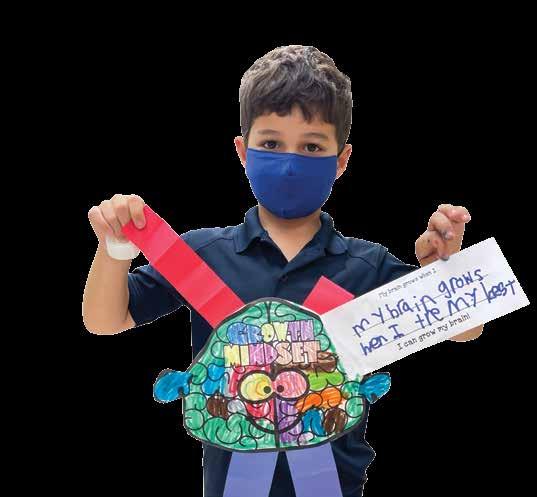
3 minute read
LEARNING in the Early Years SOCIALEMOTIONAL
“I
When passing through the halls of The Davis Academy Lower School, such phrases may be overheard as students navigate their days in and out of the classroom. Cultivating school wide verbiage is just one of the facets that results from the social emotional learning explicitly taught in the Guidance curriculum across the grade levels and is also reinforced in all aspects of the students’ day. In preparation for Middle School years and beyond.
Advertisement
Why does this matter?
Now more than ever, it is critical that school is a place where not only a child’s academic intelligence grows, but also an environment in which the whole child can be seen, heard and valued. When it comes to happiness and success, emotional intelligence (EQ) is as important as developing intellectual abilities and potential (IQ). Emotional intelligence is like a GPS that can help an individual navigate their way around obstacles and toward interpersonal and intrapersonal success.
“Kiss your brain!”
“I
How does a child learn to be Emotionally Intelligent?
It is through implicit and explicit education and application that students learn how to foster and grow their ability to understand, use, and manage emotions in positive ways, to relieve stress, communicate effectively, empathize with others, overcome challenges, and defuse conflict. Through emotional intelligence, students build stronger relationships, succeed at school, and achieve personal goals. It can also help connect with feelings, turn intention into action, and make informed decisions about what matters most.
The five principles that define Emotional Intelligence are at the backbone of the social emotional learning that takes place in Mechina through Fifth Grade: self-awareness, selfmanagement, social awareness, responsible decision making, and relationship skills. The themes and topics of this curriculum are taught in developmentally appropriate ways, using bibliotherapy, technology, arts and crafts, movement activities and discussions, and are facilitated by the Lower School Counselors, Jamie Rindsberg and Annie Peskin.
What does Emotional Learning look like in the classroom?
We Can Grow Our Brain
A Growth Mindset is a concept that becomes a guiding force early on through our students’ academic and extracurricular experiences. By learning that it is okay to make mistakes and safe to try new and challenging things, students are more likely to take risks and live up to their truest and highest potentials. Parents will likely hear about the “Power of YET” from their kindergartener who shares that they cannot ride a two-wheeler yet, and also from a third grader who has not yet mastered their multiplication facts. In first grade, students discover that when doing hard things, or trying new things and making mistakes, our “brain grows.” Resources and language are shared with parents to integrate the learning at home.
Empathy is a Superpower!
Second and third graders learn about the power of empathy. Students wear a cape and show off the superpower of empathy as they demonstrate how an empathetic person would respond or behave under different scenarios. To deepen the learning, students are divided in teams and work on an Empathy Escape Room, where they use their powers collectively to solve empathy-themed puzzles, unscramble code words, and earn empathy hearts to “unlock themselves.” Not only is it a fun activity, students learn the difference between an empathetic person and a self-involved person, as well as how to put empathy into practice in everyday situations.
Worry Monsters
Kindergarten students learn that a little bit of worry is healthy and protective, but ideally, we would like to stop a worry from growing bigger as it may keep us from doing things that we want and need to do. After reading the book, The Very Hungry Worry Monster, by Rosie Greening, students learn that lots of people worry about lots of different things and it is important to talk about it, name it, and brainstorm ways to “defeat or lessen the worry.” Students then create Worry Monsters, a variation of a worry box to help them tangibly notice a thought or worry, write it down, and let it go by feeding it to the monster. The lesson is shared in detail with parents with additional resources to support, practice, and continue the learning at home.
Growth Mindset Examples
When you think you have made a mistake, think of it as an opportunity to make something beautiful.”
Students created their own “growing brain” and shared examples when their brain grows:
• My brain grows when I… lose a baseball game and try harder next time.
• My brain grows when I… try swimming in the deep end.
• My brain grows when I… write, because it is hard.
• My brain grows when I… keep falling when I try to ride my two-wheeler.






